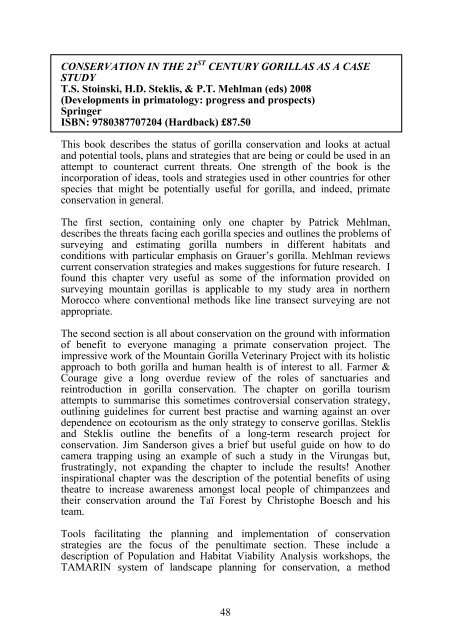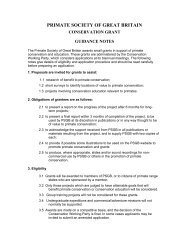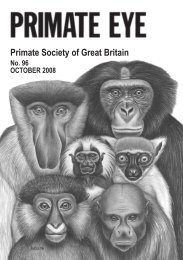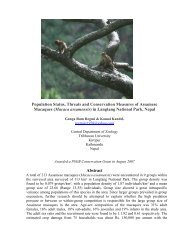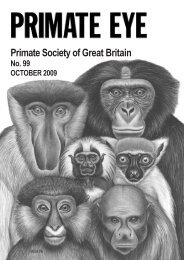2010 Vol 101.pdf (1.63mb) - Primate Society of Great Britain
2010 Vol 101.pdf (1.63mb) - Primate Society of Great Britain
2010 Vol 101.pdf (1.63mb) - Primate Society of Great Britain
Create successful ePaper yourself
Turn your PDF publications into a flip-book with our unique Google optimized e-Paper software.
CONSERVATION IN THE 21 ST CENTURY GORILLAS AS A CASE<br />
STUDY<br />
T.S. Stoinski, H.D. Steklis, & P.T. Mehlman (eds) 2008<br />
(Developments in primatology: progress and prospects)<br />
Springer<br />
ISBN: 9780387707204 (Hardback) £87.50<br />
This book describes the status <strong>of</strong> gorilla conservation and looks at actual<br />
and potential tools, plans and strategies that are being or could be used in an<br />
attempt to counteract current threats. One strength <strong>of</strong> the book is the<br />
incorporation <strong>of</strong> ideas, tools and strategies used in other countries for other<br />
species that might be potentially useful for gorilla, and indeed, primate<br />
conservation in general.<br />
The first section, containing only one chapter by Patrick Mehlman,<br />
describes the threats facing each gorilla species and outlines the problems <strong>of</strong><br />
surveying and estimating gorilla numbers in different habitats and<br />
conditions with particular emphasis on Grauer’s gorilla. Mehlman reviews<br />
current conservation strategies and makes suggestions for future research. I<br />
found this chapter very useful as some <strong>of</strong> the information provided on<br />
surveying mountain gorillas is applicable to my study area in northern<br />
Morocco where conventional methods like line transect surveying are not<br />
appropriate.<br />
The second section is all about conservation on the ground with information<br />
<strong>of</strong> benefit to everyone managing a primate conservation project. The<br />
impressive work <strong>of</strong> the Mountain Gorilla Veterinary Project with its holistic<br />
approach to both gorilla and human health is <strong>of</strong> interest to all. Farmer &<br />
Courage give a long overdue review <strong>of</strong> the roles <strong>of</strong> sanctuaries and<br />
reintroduction in gorilla conservation. The chapter on gorilla tourism<br />
attempts to summarise this sometimes controversial conservation strategy,<br />
outlining guidelines for current best practise and warning against an over<br />
dependence on ecotourism as the only strategy to conserve gorillas. Steklis<br />
and Steklis outline the benefits <strong>of</strong> a long-term research project for<br />
conservation. Jim Sanderson gives a brief but useful guide on how to do<br />
camera trapping using an example <strong>of</strong> such a study in the Virungas but,<br />
frustratingly, not expanding the chapter to include the results! Another<br />
inspirational chapter was the description <strong>of</strong> the potential benefits <strong>of</strong> using<br />
theatre to increase awareness amongst local people <strong>of</strong> chimpanzees and<br />
their conservation around the Taï Forest by Christophe Boesch and his<br />
team.<br />
Tools facilitating the planning and implementation <strong>of</strong> conservation<br />
strategies are the focus <strong>of</strong> the penultimate section. These include a<br />
description <strong>of</strong> Population and Habitat Viability Analysis workshops, the<br />
TAMARIN system <strong>of</strong> landscape planning for conservation, a method<br />
48


